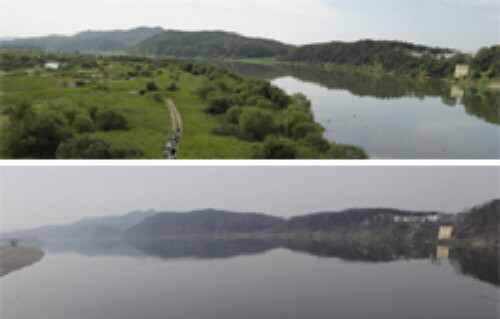hankyoreh
Links to other country sites 다른 나라 사이트 링크
[Editorial] Reversing a Four Rivers disaster

Previously expressed concerns about the Four Major Rivers Restoration Project are proving well-founded. Blocked off by large weirs, the rivers are turning into huge “water jugs,” and tributaries are being rapidly eaten away by major dredging on the main courses. Concerns are already being voiced that serious flood damages may occur during this year’s rainy season. It is also impossible to guarantee that there will not be any additional water supply interruptions like the ones that have taken place in Gumi and other regions. All of this is the result of a rush job on the construction, with the effort pushed hastily to meet a prescribed deadline. This speed campaign should immediately end, and the entire project should be submitted for reexamination.
With more than 70 percent of the effort complete, the rivers are taking on a completely different appearance. Gone, for the most part, is the old character of the rivers, which, owing to the topography of the Korean Peninsula, previously meandered along forming rapids and sandy beaches. In the case of the South Han River, blockage by large weirs is turning the river water into a giant water jug. And the change is not merely external. Concerns are being expressed that water quality may deteriorating as the flow of the water slows. These were things that were anticipated early on with this project. It is apparent that if the natural courses of the four rivers turn into this kind of artificial waterways, there will be greater flood damages when the rainy season comes.
More serious are the damages to the rivers’ tributaries. Increasing water level differences between the main courses and their tributaries due to large-scale dredging are giving rise to a “reverse erosion” process that has seen the collapse of banks on the smaller courses. This was borne out by a study of South Han River tributaries last week by a “joint citizen investigation team,” which found the loss of riverbed protection work due to last week’s rains and typical signs of reverse erosion such as the collapse of embankments. This is something that has been pointed out repeatedly by experts, with a similar incident occurring on a tributary in the Yeoju area during last September’s heavy rains. This situation will become even more severe with heavy rainfall after the completion of the Four Major Rivers Restoration Project.
The Lee administration has continued to adhere to the line that the project has entered its final stages and cannot be undone. The situation is such that it is impossible for anyone to argue otherwise within the Lee administration, since President Lee himself has taken the initiative. But if the construction continues through to completion as it, the best that can be hoped for is a large-scale version of the “Lee Myung-bak brand Cheonggyecheon stream.” That waterway is nothing more than a narrow stream, but it is awful to think of the disasters brought about by the “Cheonggyecheon-ized four rivers.”
They may argue that the construction is too far along, but there is still a chance. The effects of the project should be carefully examined and preliminary measures established to address them. It is too late for regrets when disaster strikes.
Please direct questions or comments to [englishhani@hani.co.kr]
Editorial・opinion
![[Column] Season 2 of special prosecutor probe may be coming to Korea soon [Column] Season 2 of special prosecutor probe may be coming to Korea soon](https://flexible.img.hani.co.kr/flexible/normal/500/300/imgdb/original/2024/0426/3317141030699447.jpg) [Column] Season 2 of special prosecutor probe may be coming to Korea soon
[Column] Season 2 of special prosecutor probe may be coming to Korea soon![[Column] Park Geun-hye déjà vu in Yoon Suk-yeol [Column] Park Geun-hye déjà vu in Yoon Suk-yeol](https://flexible.img.hani.co.kr/flexible/normal/500/300/imgdb/original/2024/0424/651713945113788.jpg) [Column] Park Geun-hye déjà vu in Yoon Suk-yeol
[Column] Park Geun-hye déjà vu in Yoon Suk-yeol- [Editorial] New weight of N. Korea’s nuclear threats makes dialogue all the more urgent
- [Guest essay] The real reason Korea’s new right wants to dub Rhee a founding father
- [Column] ‘Choson’: Is it time we start referring to N. Korea in its own terms?
- [Editorial] Japan’s rewriting of history with Korea has gone too far
- [Column] The president’s questionable capacity for dialogue
- [Column] Are chaebol firms just pizza pies for families to divvy up as they please?
- [Column] Has Korea, too, crossed the Rubicon on China?
- [Correspondent’s column] In Japan’s alliance with US, echoes of its past alliances with UK
Most viewed articles
- 1[Column] Season 2 of special prosecutor probe may be coming to Korea soon
- 2No good, very bad game for Korea puts it out of Olympics for first time since 1988
- 3‘We must say no’: Seoul defense chief on Korean, USFK involvement in hypothetical Taiwan crisis
- 4Division commander ordered troops to enter raging flood waters before Marine died, survivor says
- 5Is Japan about to snatch control of Line messenger from Korea’s Naver?
- 6Korea’s 1.3% growth in Q1 signals ‘textbook’ return to growth, says government
- 7Is N. Korea threatening to test nukes in response to possible new US-led sanctions body?
- 8[Editorial] Korea’s surprise Q1 growth requires objective assessment, not blind fanfare
- 9[Editorial] New weight of N. Korea’s nuclear threats makes dialogue all the more urgent
- 10[Editorial] In the year since the Sewol, our national community has drowned